1. Planning a Magazine
We’ve come quite a long way since the very first American publication in 1741. Who knows if Ben Franklin and his chronicling competitors had any idea that their budding industry would blossom into something that has a global market size of more than $100 billion this year?
Thanks to both their centuries-long resilience and progressive nature to adapt, magazines continue to be a worthwhile project to embark on.
If you’re looking to start a magazine or pivot to digital editions, read on. We’re outlining the basic steps of how to start a magazine in 2025.
i. Choose a Niche
The first step to starting your magazine is, of course, to choose a concept. Before you venture down the path on how to make a magazine, you need to know what you want to write about in your publication.
Will it handle a general topic, such as business or politics?
Do you want to get down to the nitty gritty of gardening or interior design?
Be sure to choose a concept that you will be able to generate ideas around.
Magazines have been around for centuries, so chances are that there’s already a plethora of publications on your chosen topic. How would you tackle the topic differently? Or present it in a unique, fresh way?

It’s not as simple as just choosing a topic, however; you should also consider who your primary audience would be.
What type of readers are you targeting?
What’s the demographic profile? Think in terms of age, interests, education level, family dynamics, and so on.
Knowing your audience will help to keep you established and focused in the niche you’re pursuing. Because just as Michael Keaton’s Ray Kroc learned in The Founder — when the McDonald’s businessman learned he wasn’t, in fact, in the hamburger business, but rather the real-estate business — it’s essential to remain true to the business of The Niche even as people can’t keep their hands off the publication.
Beyond your concept, other factors to consider are:
- The title. Your audience’s first impression of your publication comes from its title. Make sure it’s concise, catchy, relevant, and distinguishable. Your magazine should stand out from others in your topic.
- The tone and message. Though all writers and editors bring something different to the table, the overall tone of the magazine should be consistent and relevant to your topic. For example, an upbeat tone is fine for an entertainment magazine; pulling off that tone for a political publication would take considerably more skill and effort.
- The stylistic elements. Generally, you want the font type, size, and color to be uniform across all of your editions. Like branding in marketing, you have to develop a style for your magazine.

The initial stages of developing your concept will involve lots of research. However, it ensures that you’re organized and have a clear vision as you develop your publication.
ii. Create a Business Plan
Think of your up-and-coming magazine as a company. It’s not just a publication. It’s a brand, a business. As with any venture, you need to devise a solid plan.
Using your concept research, build a business plan that addresses the logistics of starting a magazine. Priority considerations include:
- How will you fund your first issue? Some aspiring publishers have money saved up while others look to crowdfund or use investors.
(As you grow, you may be able to rely on advertisements to finance issues. Until then, it’ll likely be difficult to get advertisers until your publication is more established.)
- How will you distribute your magazine? If it’s a print publication, how will you print it? If it’s digital, where would it be available to read or to download?
- Would you rent or buy office space, or would staff work from home? Think about the added costs of office supplies, insurance, energy and Internet bills, and more.
- Where will your magazine be distributed, regionally or nationally? Magazine start-up costs range from $100,000 to $1 million, depending on geographic circulation.
- Speaking of, will your magazine be a free or paid circulation? If it’s free, who’s the most relevant audience to distribute to? If it’s paid, how much will you charge subscribers? (Most publications make revenue from subscriptions, advertisements, or a combination of the two.)
- What type of advertisements would you plan to include? Can advertisers count on package deals or special considerations with any digital outreach or editions? (As always, if you choose to have ads, ensure they’re relevant to your audience.)
Pro Tip: If you will be relying on ads for revenue, you will want ads to cover at least 50% of your publication, and closer to 60-65% if you’re relying solely on ad revenue.
- Do you intend to make a profit from your magazine? Is this venture not-for-profit?
Pro Tip: If you’re trying to increase revenue, keep printing and distribution costs below 50% of your total budget.
- What are your basic editorial topics? Most first-time publications plan a content calendar at least a year in advance. In addition to providing solid footing for the editors, this also allows publishers to give advertisers a better sense of the magazine’s scope and direction.
iii. Hire Your Staff
In every film involving magazines (and newspapers), it’s all about the staff. Your team members take ideas and mold them into stories. They give a voice and visual to each individual page and to the larger brand.
Because they’re so important, don’t skimp out on hiring a dream team of editorial all-stars to get your magazine off the ground. Though you may not yet have the budget to hire a full staff, you’ll at least want these essential members in your corner, laying the foundation:
- Editor-in-Chief: To oversee all aspects of the editorial process.
- Managing Editor: To assign stories and edit text
- Copy Editor: To fact-check and edit for grammar
- Staff Writer: To write articles, website content, etc.
- Production Manager: To keep track of ads and handle bookkeeping
- Salesperson: To sell advertisement space in your magazine
- Creative Director: To design the publication style and more prominent features
- Graphic Artist / Designer: To design department layouts and graphics
- Photographer: To take high-quality pictures
- Digital Content Editor: To create complementary editorial content for website and across all online channels
Other positions to consider down the line (or on a freelance basis):
- Proofreader: for reviewing the text in each issue
- Photo Editor: for scouring stock-image sites and other photo research
- Associate Editors: for assigning and editing text in specific departments
- Advertiser Account Managers: for handling accounts as they come in
- Editorial Assistants: for helping with assorted editorial logistics
An editor’s salary can run between $50,000 and $125,000 per year, depending on factors such as experience, location, etc. When hiring a top-notch editor, focus on finding a candidate with impeccable writing skills, an eye for detail, and a knack for deadlines and organization. Have them include writing samples or a sample assignment to ensure their skills are near perfect. Tone can be taught, but basic grammar, spelling, and punctuation are necessary from the get-go.
As for a salesperson, costs fall between $30,000 to $40,000 annually for a base salary, plus at least 10% commission. Hiring a dependable salesperson is a little trickier than an editor. As with an editor, you want someone with basic skills. Great salespeople hone “soft” skills like communication, customer service, and interpersonality.
Ideally you want someone who also has experience selling similar products. However, product knowledge can be taught, so lower that priority. As a general business rule of thumb, hire a salesperson that you can genuinely sit down and have a conversation with. If they’re personable, chances are they’ll do great in the field.
A production manager’s annual salary can range from $30,000 to $60,000, depending on their experience level. If you’re financially savvy and the rest of your staff is willing to take on whatever tasks are thrown their way those first few months, you may be able to get by without a production manager initially. As revenue and ad sales grow, however, you should definitely look into hiring one.
If you’re looking to save money, outsource your writing, design, and photography needs by hiring freelancers.
Costs for freelancers differ based on industry and experience:
- Freelance writers might accept as little as $0.50 per word if they can appreciate the topic or the potential of the magazine itself. Whether you assign per-word or per-project, be sure to communicate word-count expectations clearly.
- Graphic designers vary from $25 to $300 per hour. This is worth a little extra, because a great eye for color and layout is hard to come by. They can even help first-time publishers develop a new brand.
- Photographers range from $25 to $250 per image. Equally as important as copy, photography is a necessary expense for magazines.
Luckily, it’s the 21st century, and freelancers are everywhere. Any decent editor will have a stable of reliable writers at the ready, but you can fit your needs and budget with this quick list of resources available for your editorial needs:
- Upwork (www.upwork.com): One of the most popular freelancing sites, Upwork provides opportunities in over 70 different job categories. Millions of freelancers offer over 5,000 skills for 4 million businesses, making this site a great option for publications looking to hire for multiple positions from one platform.
- Behance (www.behance.net): Behance is a platform by Adobe specifically intended for designers to showcase their work. It allows publications to explore candidates around the world. The best part is that the platform is entirely free, which is ideal for those looking to cut costs.
- PeoplePerHour (www.peopleperhour.com): Smaller freelancing platform PeoplePerHour requires users to send a proposal to companies. This is beneficial for first-time publishers who don’t have the time to sift through resumes of prospective employees.
- YunoJuno: YunoJuno is a great platform, especially if you’re searching exclusively for designers. They seek to attract top-tier graphic artists, so if magazine design is one of your priorities, look into this amazing freelance space.
- Freelancer: Freelancer is the largest freelancing website out there. Their matching process consists of a bidding system and allows employers to view past projects and portfolios before hiring someone.
Other websites to hire specialty team members include Fiverr, WriterAccess, and Guru (which also includes translation services if you’re producing a multilingual magazine).
Pro Tip: Though not directly part of your editorial team, you also need to find a reliable printer during the hiring stage. Ultimately, a Creative Director or Production Manager will manage the issue-to-issue operations.
If you’re distributing your publications, look for a printer who also distributes. This will save you the time and money of hiring two separate companies.
When your magazine is more established, you should look into hiring a digital marketer. They’ll promote your publication and manage your social media channels.
iv. Make Use of All Platforms
One of the most important considerations for starting a magazine in 2025 is making use of all possible platforms, particularly in the interest of marketing. This means taking advantage of all channels to post and promote your magazine and engage with your readers. The best magazine publishing software will equip you with marketing tools to reach new, interested audiences.
- One way to promote is to send out an email newsletter to your subscribers. Give them industry updates, the latest editions, sneak peaks of articles, and more. By providing digital content for them to read, you keep them engaged with your magazine.
- Posting digital content has the potential to become an additional stream of revenue — if you require online subscribers to pay a fee. However, this gates your content and prevents readers from sharing it, which hurts engagement and readership.
Initially, it’s recommended that you provide online content at no charge and leverage advertisements to generate revenue. Some digital magazines ask for subscriptions in exchange for articles. See this example from The Guardian:
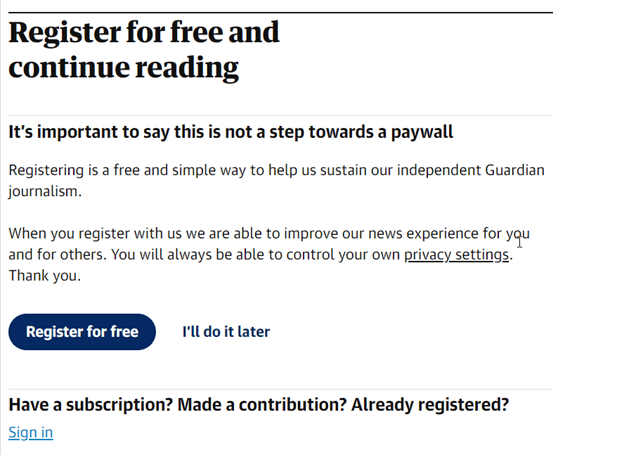 If you see growth from your magazine, your content is likely valuable enough that people would be willing to pay for it. Consider introducing a fee or capping your content off at a certain number of articles. This is called a journalism paywall, as evidenced by Vanity Fair:
If you see growth from your magazine, your content is likely valuable enough that people would be willing to pay for it. Consider introducing a fee or capping your content off at a certain number of articles. This is called a journalism paywall, as evidenced by Vanity Fair:

- Use social media to further enrich your brand. You can do this by providing food for thought for your readers, asking questions to get them engaged, or creating videos to support your written content.
- Podcasts have become increasingly popular over the past few years. Creating a podcast for your magazine in which you explore related, relevant topics could engage your audience and even help you reach new readers.
Including ads in your podcasts is another potential source of revenue, and you can also reuse podcast clips as social media content.
- The most traditional method of promoting your publication is to distribute it strategically. Even in today’s digital world, this remains essential.
In addition to your subscribed readers, be sure to send a sample of your publication to potential and existing advertisers. If your publication is free, send your magazine to relevant readers in the industry.
For example, if you run a business magazine, it might be a good idea to send it to prominent professional figures, local businesses, networking events, and more.
Businesses with waiting rooms, like doctors’ offices, and colleges and universities are also great places to distribute your publication.
- You can build your circulation and subscriber lists through more traditional methods, such as cold calling, street team promotion, or direct mail.
All of these tactics will bring awareness — and thus, subscribers — to your new magazine.
2. Launching Your First Issue
So, you’ve ironed out most of the initial kinks and are ready to create content for your magazine. You want your first issue to be palatable, welcoming enough to draw in a readership … but with all of the magazines that exist, your launch must also stand out.
Creating content is not a linear process, so reading a step-by-step guide will not be helpful. It may even distort your creative process. But the basics are hard to argue with.
Stay up to date not just with other publications that cover your topic, but with specific keywords and conversations being had across all social media. And participate and be active in those niche sectors so you can get a better sense of where people’s interests are currently and where they might be headed. Along with active listening on your topic, make sure to get feedback on your efforts as well.
Here are some additional suggestions to keep in mind:
- Your topic should be specific enough to pique interest, but broad enough to generate article ideas around.
- Consider topics that are generating conversation among your audience, and position your issue as part of that conversation.
- Make sure your topic is relevant to both your audience and the overall concept of your publication.
As mentioned earlier, it is recommended that you plan out your editorial content at least one year in advance. You can always adjust editions to reflect relevant events and trends, but planning out your content all at once will save you lots of time down the road.
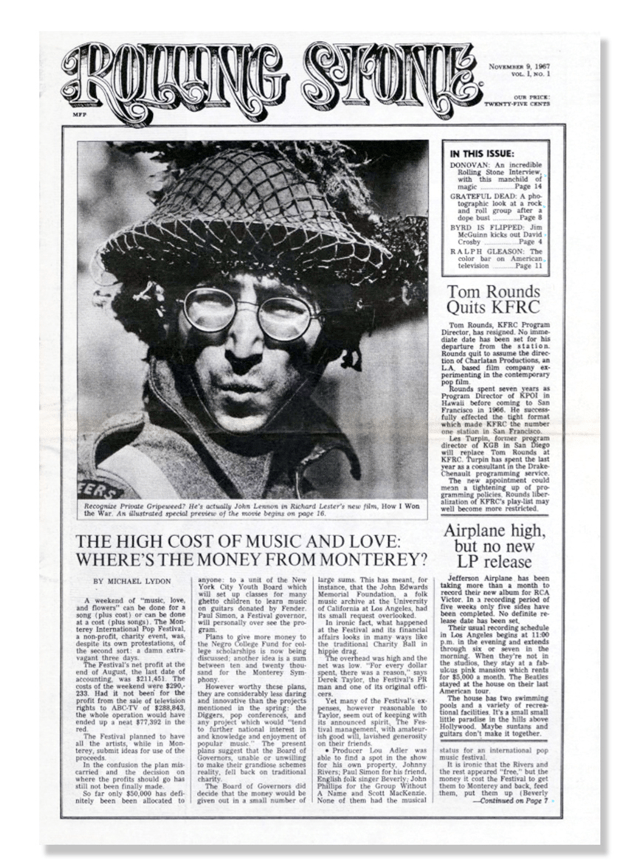
i. Rounding up content and creating a mock-up
Once you’ve chosen your topic, you’ll need to create a mock-up of your issue.
While your content doesn’t have to be finalized in this stage, it is important to have a general idea of what your issue will contain.
Plan to include a variety of content. Aim for a good mix of articles, interviews, and opinion pieces. Above all, make sure your content is helpful to readers by providing actionable information.
Article, design, and photography assignments should be given well before the mock-up is finished. This will ensure that you will receive all of your content in time for your launch.
Though you may want to keep your costs as low as possible, do not cut corners on content acquisition. High-quality content is well worth the investment.
If you outsource your content, it would be a good idea to create a style guide. This will ensure that your content is consistent, even if your creators are not.
Pro Tip: “A copy editor will take your magazine from good to high-quality … This person provides a fresh, outside set of eyes to go over what you’re creating, and offers insights you would likely miss … Copy editors police your use of grammar, spelling, and punctuation [and] ensure a consistent writing style for your magazine.”
The tasks of writing the articles and curating the images would likely be left to your staff. However, as the founder, you should work hand-in-hand with your designer(s) to create a mock-up that fits your vision. From title treatment and cover concept to the layout of articles and ads, this mock-up will serve as the blueprint for your issue. As you receive finalized content, your graphic designer will stylize it and replace the fillers.
Mock-ups should also be included in your media kit, a package of information and content with which you pitch your magazine to advertisers. A well designed mock-up will make your pitch that much easier to sell.
Pro Tip: To visualize your issue without finalized content, use Lorem ipsum text (aka greeking) to fill in empty text boxes and images from the internet as placeholders.
ii. Tools to create your issue
Of course you can’t create your issue, or even the mock-up, without the right tools. Luckily, there are tons to choose from. Here are a few suggestions:
InDesign
InDesign is an offering from Adobe’s Creative Cloud (www.adobe.com/creativecloud) that allows graphic designers to create posters, brochures, magazines, and even interactive eBooks.

Pros:
- Highly intuitive, user-friendly software
- Media is easily exported in a variety of formats
- Access to Photoshop tools and effects for images
Cons:
- Does not lend itself well to more detailed designs
- Text spacing requires manipulation, as it is known to look uneven at times
- One of the pricier options on this list
Price: Adobe offers a 7-day free trial of InDesign. Otherwise, it is available as part of a subscription to Adobe Creative Cloud. It will cost either $22.99 for the single app or $59.99 for the entire design suite.
DigitalStudio
DigitalStudio is a flat-planning and pagination software by Mirabel Technologies (www.mirabeltechnologies.com), created specifically for magazine publishers. The best magazine software will not only give you the basics for creating that first issue, but for setting a foundation for every issue to come, from design and production to marketing and management.
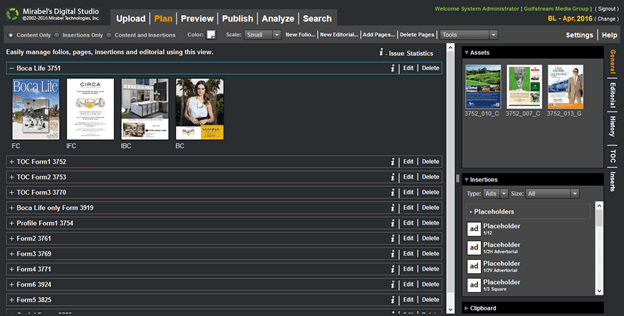
Pros:
- Allows users to accommodate ad units and paginate as live inventory changes
- Interactive software designed for team collaboration
- Includes free publishing to Mirabel’s Magazine Central, a digital magazine stand
- Designed exclusively for magazines
Cons:
- Included only as part of a Magazine Manager (www.magazinemanager.com) subscription to its magazine publishing CRM software
A subscription to the magazine management software includes DigitalStudio, access to a powerful publishing CRM (with full publishing ERP software capabilities), electronic invoicing to bill advertisers, and top-tier support services.
Considering the large scope, it’s the software magazine designers, production staffers, and sales teams alike can utilize together. Publishers looking for magazine software that sets a management foundation and provides room to grow digitally need look no further.
Microsoft Publisher
Microsoft Publisher is a design program that comes exclusively with a Microsoft 365 (www.microsoft.com/microsoft-365) subscription. If you use Microsoft, as most businesses do, this might be a great option for you.
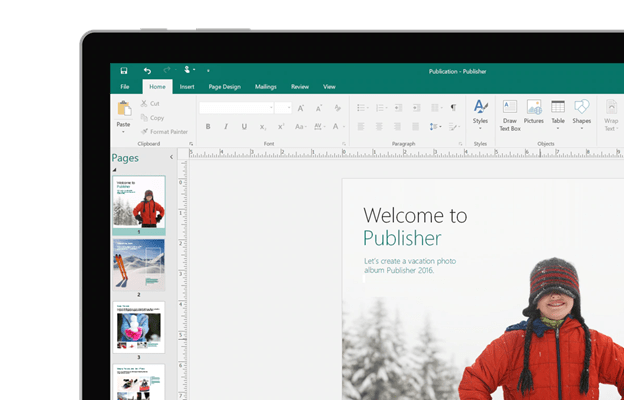
Pros:
- User-friendly interface, drag-and-drop capabilities
- Tons of templates to choose from
- Guidelines to ensure that your content is perfectly aligned
Cons:
- Only available through Microsoft subscription
- Only available for PC
- Not compatible with other programs, such as Adobe
Price: Microsoft offers a 1 month free trial of Publisher, through its trial of Microsoft 365.
The annual subscription for Microsoft 365 Business Premium is $22/user/month, and includes all of the Microsoft 365 products, along with their secure cloud services.
iii. Post-Launch
The next step is, of course, distributing your publication. In addition to the distribution suggestions earlier, you can build your circulation and subscriber lists through traditional methods, such as cold calling, street team promotion, or direct mail.
Eventually, consider a magazine subscription software, such as Mirabel Technologies’ ChargeBrite platform, to help manage magazine subscription data and recurring revenue.
Obviously, your work is not finished after you distribute your publication. After distribution, you should follow up with your readership. You can do this by sending a postcard or email asking for feedback.
One of your primary objectives is to satisfy your readers, so their feedback is essential as you move forward with your publication.
Following up is especially important after your first issue.
Keep track of the things your subscribers enjoyed. Those elements should remain consistent across your editions. If they enjoyed a specific promotion, consider repeating it in a later edition.
On the same note, keep track of the things that your readers were critical of. These will be the things you should focus on fine-tuning as your publication progresses.
3. Marketing a Magazine
i. Create a Brand
You need a consistent, effective marketing strategy to draw in new readers and keep existing subscribers engaged. When marketing a new magazine — or product of any kind — it’s important to create a brand.
Let’s circle back to the beginning, and the very first steps we discussed in starting your publication: specifically, establishing a niche or concept that it centers around. It considers a market with a continuous interest in or need for your content, as well as:
- Title
- Topic
- Audience
- Messaging
- Stylistic elements
As Small Business Chron put it:
“Don’t just sell your content. Sell the benefits of reading your magazine. The more you create a niche for your magazine, or develop a specialized image or brand, the more likely you can generate an affinity for your publication with specific consumers.”
It’s not enough to generate great copy and design striking visuals. A brand is the element that keeps readers coming in and coming back.
ii. Diversify
Another key strategy to get readers interested in your publication is to diversify your content. Consider adding a product or service to complement your publication.
This could be as simple as creating long-form content, such as books, guides, or whitepapers, on topics that might interest your audience.
It can be as complex as organizing community events or workshops that relate to your niche.
For instance, the popular lifestyle magazine Kinfolk (www.kinfolk.com) would host “global gatherings held in over 25 locations worldwide” to celebrate their magazine launches. At these events, they focused on forming genuine connections with their readers.

This is just one example of the way that a magazine can diversify by hosting events.
A restaurant/food and drink magazine might consider organizing a cooking or bartending class that their readers can attend for a small fee.
A fitness magazine may hold a marathon and donate the proceeds to an athletic-minded charity. This diversifies their brand and positions the magazine positively in front of their audience.
Content diversification can be adapted to a digital format, as well. A podcast that touches on topics relevant to your magazine is another way to supplement its content. It could potentially create an additional revenue stream, too, if you decide to include ads.
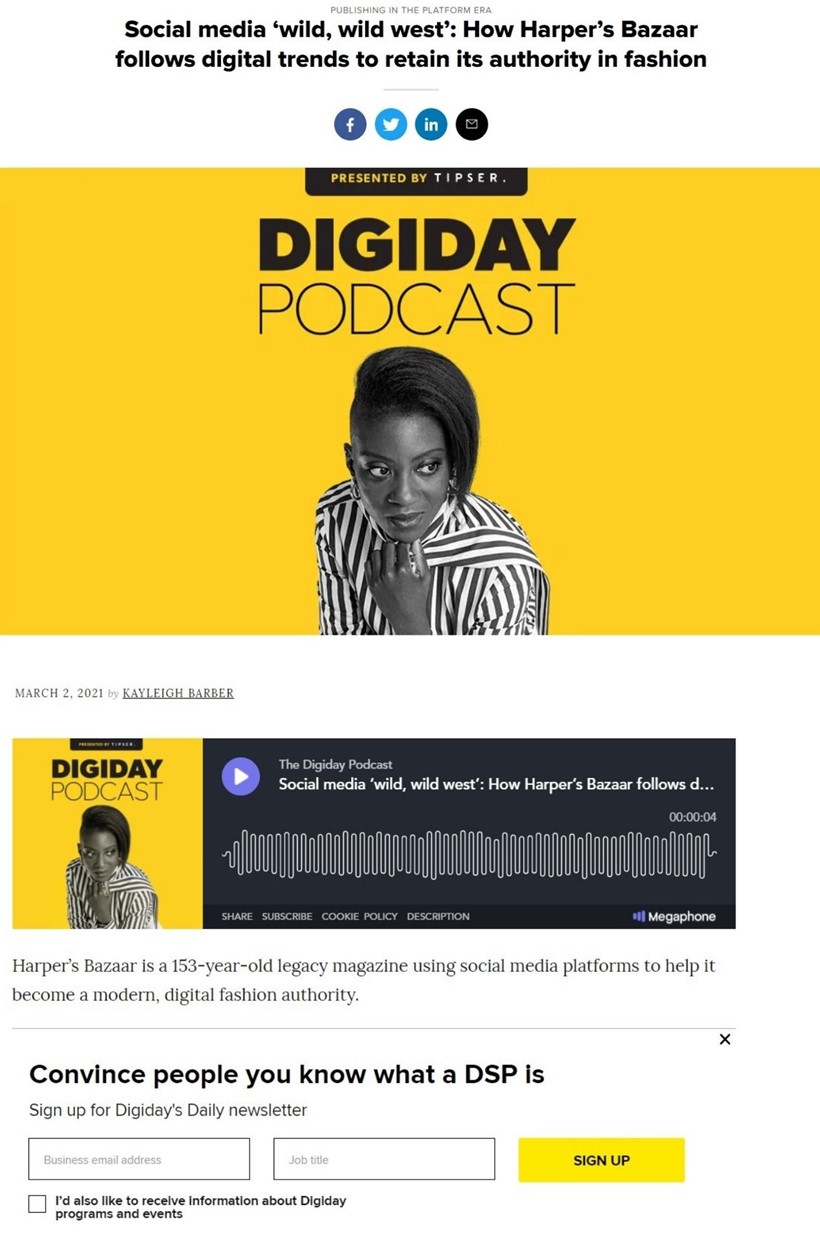
Diversification can also mean giving readers a variety of subscription types to choose from.
“The digital era is all about options,” according to Mag+. “Why not give your readers a range of subscription choices from a single issue to multi-year subscriptions?”
No matter how you choose to provide additional value to your subscribers, it makes all the difference in marketing a magazine.
iii. Develop Quality Content
Without quality content, the readers you attract will not be retained.
You need to ensure that you’re strategizing and developing high-quality content in every issue.
With thousands of publications in the U.S. alone, it’s likely that many of them touch on the same or similar topics as yours.
In order to differentiate yourself, or carve out a space amongst similar big-name publications, your content must set the new standard.
You want your content to organically generate new subscribers. It’s a slow long-term strategy, but it’s worthwhile because the quality of subscribers is better.
So, what does quality content look like?
Quality content offers readers more than words on a screen or a piece of paper. It connects with readers and gives them content that’s actionable or, at the very least, thought-provoking.
This is no easy feat.
It can be hard to find content that people will read, much less connect with.
To figure out which content is best for your readers, a great strategy is to analyze successful existing content. Which pieces are they engaging with most? Where are they sharing it online?
The State of Digital Publishing makes a case:
“Data analyzing is the key to increasing promoting efforts. The better you know your audience, the easier it will be to keep them and reach new ones. Investigate what content your users read most often, what is most often shared, and what social networks your readers are most active on.”
Another good strategy is to ask your readers what content they’re interested in seeing from you. Put a pop-up on your website, send a reader’s poll through email, or reach out with a survey.
iv. Use your channels — all of them!
Don’t limit the ways that your subscribers can enjoy your content.
Use all possible mediums to your advantage:
- Print magazines
- Digital editions
- Video (interviews, behind-the-scenes, sneak peeks)
- Social media polls and links to articles
- Podcast interviews
- Relevant events and/or awards
The importance of diversifying your content and platforms go hand in hand. For example, a podcast is one way you may choose to use audio content to your advantage.
If your magazine is primarily a print publication, consider providing a digital edition to reach a wider audience or vice versa.
Pro Tip: If you decide to host digital content, strategize whether this content will be freely available or reserved for subscribers. A mixture of both is ideal, because a variety of options ensures that you’re reaching as many people as possible.
Try to provide content that’s accessible to the general public, and reserve exclusive content for subscribers. Using this technique, new visitors/potential subscribers get a few sample articles before committing to a paid subscription. Many digital magazines ask users to provide an email address to view all your digital content. This is a great way to build an email list, which can also be used to engage with subscribers.
Beyond digital and print versions of your publication, it’s a good idea to supplement your content through social media. Content on social media is easily shareable, making it an ideal place to reach new readers.
There’s a variety of content to post on social media, including:
- “Fragments of the best content which hasn’t been published yet and which will spark the discussions under a social media post,
- Videos or photos from behind the scenes of an interview, unpublished or additional material
- A discount offer for social media users (in exchange for sharing the content/a post) or newsletter readers (in exchange for signing in).”
You can also use your social media to promote upcoming issues. Per the State of Digital Publishing (www.stateofdigitalpublishing.com):
“Before film producers release a new project, they present a movie trailer. The goal is clear – encourage people to go to the cinemas, buy tickets, and watch the film. My tip for you is to be like a movie producer.”
Social media may also be a place to further promote your brand itself. Twitter and Instagram, for example, are great places to showcase the personality behind your publication.

Similarly, LinkedIn (www.linkedin.com) is a great platform to showcase your brand professionally. LinkedIn “drives 46% of social traffic to B2B sites and is considered the most credible source of content.”
When sharing content to LinkedIn, keep in mind that it’s more likely to be clicked if it includes an image. Also, consider posting video content, as it’s the most commonly shared on the platform.
As we mentioned above, you may choose to require users’ to provide an email address in order to view your digital content.
This is because an email newsletter is another great way to keep subscribers engaged. Use it to share updates, as well as new or relevant content based on a user’s past interactions with your articles.
You can send them more of your free content, and perhaps include an exclusive article or two to entice them to subscribe. Ultimately, marketing CRM software can help not only create this engaging content, but automate how it gets to your audience effectively as well.

It may take time to garner a large audience, but it’s a numbers game. The more variety you afford readers to view your content, the better your chances are.
Conclusion
It takes the strength of multiple tactics to effectively create and market a magazine. These tips are really just the beginning.
However, by incorporating these elements into a strategy that suits your vision, you’ll be well on your way to a loyal readership and a publication to be proud of.
SEE FOR YOURSELF
The Magazine Manager is a web-based CRM solution designed to help digital and print publishers manage sales, production, and marketing in a centralized platform.




